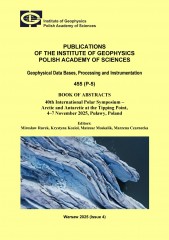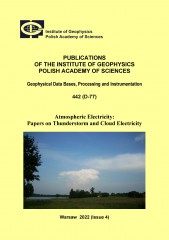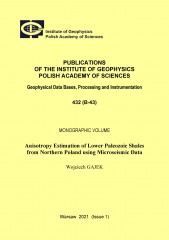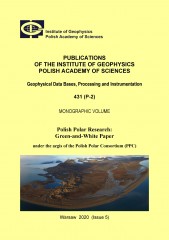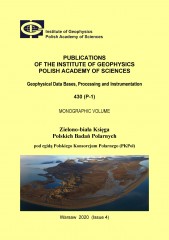Collections of papers relating to specific topics, events, measurement campaings, conferences, symposia or workshops may be published "Special issues". The proposals are welcome. Please use our proposal form (Publication_Proposal_Form.doc).
SPECIAL ISSUES
SEARCHING FOR:
- special issues [disable]
- special issues [disable]
Special issues
BOOK OF ABSTRACTS. 40th International Polar Symposium – Arctic and Antarctic at the Tipping Point, 4–7 November 2025, Puławy, Poland
Editor(s): Rurek M., Kozioł K., Moskalik M., Czarnecka M.
Volume: 455
Series: P-5
DOI: 10.25171/InstGeoph_PAS_Publs-2025-067
Volume: 455
Series: P-5
DOI: 10.25171/InstGeoph_PAS_Publs-2025-067
The Polar Symposium is a recurrent conference, typically occurring every two years, dedicated to Arctic and Antarctic topics, with a long tradition dating back to 1972. Since then, these meetings have been an excellent opportunity for integrating the polar community, exchanging experiences, and a discussion between Polish and international polar researchers representing various scientific disciplines. The Polar Symposium is currently co-organised by the Committee of Polar Research, Polish Academy of Sciences, and the Polish Polar Consortium, and until recently it has also been co-organised by the Polar Club of the Polish Geographical Society. Instead, during the 40th International Polar Symposium, a new Polish Polar Club will debut as an independent association, thus continuing the functioning of the Club since 1974.
Atmospheric Electricity: Papers on Thunderstorm and Cloud Electricity
Author(s):
Volume: 442
Series: D-77
DOI: 10.25171/InstGeoph_PAS_Publs-2022-020
Volume: 442
Series: D-77
DOI: 10.25171/InstGeoph_PAS_Publs-2022-020
Problems of thunderstorm and cloud electricity still remain in the mainstream of research of atmospheric physics researchers. Hence, in this special issue of Publications of the Institute of Geophysics, Polish Academy of Sciences, devoted to problems of atmospheric electricity, we present a set of six articles in which we publish some recent results on this subject, obtained by us and our co-workers.
Anisotropy Estimation of Lower Paleozoic Shales from Northern Poland using Microseismic Data
Author(s): Gajek W.
Volume: 432
Series: B-43
DOI: 10.25171/InstGeoph_PAS_Publs-2021-001
Volume: 432
Series: B-43
DOI: 10.25171/InstGeoph_PAS_Publs-2021-001
Downhole microseismic monitoring is a widely used tool for the assessment of hydraulic fracturing job effectiveness. During the process of fluid injection into the reservoir, new fractures develop due to the induced pressure, which gives rise to microseismic events. Therefore, the knowledge of an accurate velocity model is necessary in order to locate the induced micro-seismic events. Subsurface complexity is often raised by a horizontal layering, an intrinsic anisotropy of shales, and aligned fracture sets. That introduces anisotropic effects into the velocity field. In such a case, the anisotropy should be taken into account during the velocity model building. Otherwise, some errors will be introduced into the microseismic event locations, and hence, the interpretation of treatment effects will be biased. Therefore, this thesis is devoted to the anisotropy estimation using downhole microseismic data.
Polish Polar Research: Green-and-White Paper under the aegis of the Polish Polar Consortium (PPC)
Author(s): Lewandowski M., Polkowska Z., Ziaja W., et al .
Volume: 431
Series: P-2
DOI: 10.25171/InstGeoph_PAS_Publs-2020-006
Volume: 431
Series: P-2
DOI: 10.25171/InstGeoph_PAS_Publs-2020-006
The aim of this document is to present the current state of Polish research in the polar areas, as well as to suggest the main directions for further development of this research, taking into account its educational and cognitive importance and its social and economic utility. The book is addressed to the state administration and the scientific communities in Poland, those already engaged in polar studies as well as those seeking new openings in their current research. The book should also be a starting point for updating the current Polar Research Strategy.
Zielono-biała Księga Polskich Badań Polarnych pod egidą Polskiego Konsorcjum Polarnego (PKPol)
Author(s): Lewandowski M., Polkowska Z., Ziaja W., et al .
Volume: 430
Series: P-1
DOI: 10.25171/InstGeoph_PAS_Publs-2020-005
Volume: 430
Series: P-1
DOI: 10.25171/InstGeoph_PAS_Publs-2020-005
Niniejsze opracowanie ma na celu przedstawienie aktualnego stanu polskich badań przyrodniczych, prowadzonych w obszarach polarnych, a także zasugerowanie głównych kierunków rozwoju tych badań w Polsce, z uwzględnieniem ich znaczenia edukacyjno-poznawczego oraz społecznej i ekonomicznej użyteczności. Adresatami Księgi są zainteresowane problematyką jednostki administracji państwowej oraz środowisko naukowe w Polsce, zarówno polarne jak i poszukujące nowego otwarcia w swojej działalności badawczej. Księga powinna także stanowić punkt wyjścia dla aktualizacji obecnej Strategii Badań Polarnych.


